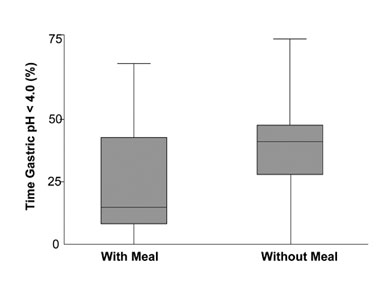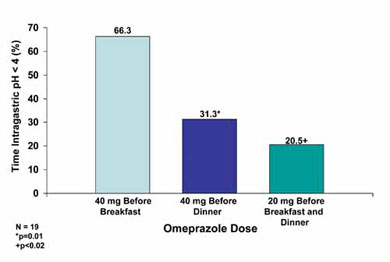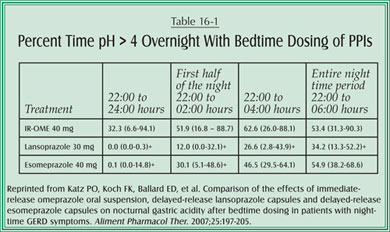A Pharmaceutical Rep Tells Me That PPIs Often Fail Because Patients Do Not Take Them as Directed
All available proton pump inhibitors (PPIs) are indicated for once-daily dosing, usually in the morning. Although food has different effects on the bioavailability of each molecule and meal timing may not affect bioavailability of rabeprazole or pantoprazole, it is my practice to recommend that all PPIs be given prior to meals for optimal efficacy. This is based on the concepts outlined in Question 15 and results of an intragastric pH study performed in our laboratory in which significantly superior daytime pH control (time intragastric pH >4) was seen when the PPI was taken before breakfast, compared to an empty stomach in the morning with no food until noon (Figure 16-1).

Figure 16-1. Improved intragastric pH control when proton pump inhibitor is given before breakfast and a breakfast meal is ingested. I routinely recommend before meal dosing, regardless of which proton pump inhibitor is chosen as this eliminates any issue of meal timing and is easy for the patient to remember. The drug can be taken when the patient wakes up, while they are preparing a meal, or while waiting for the meal they order in a restaurant.
However, some patients, in particular those with extraesophageal symptoms or complicated disease, need more than a single daily dose of PPI. In these cases, splitting the dose and giving a PPI twice daily, before breakfast and dinner, provides superior intragastric pH control, particularly at night, when compared to a double dose given once daily. Control in daytime pH was similar regardless of when a PPI is given; however, nocturnal pH control is significantly improved with the twice-daily regimen compared to double dose once daily (Figure 16-2).

Figure 16-2. Improved nocturnal pH control with a twice-daily dose compared to double dose once daily and improvement in nocturnal control with an evening dose compared to morning, a useful strategy if the patient will comply. (Reprinted from Hatlebakk JG, Katz PO, Kuo B, Castell DO. Nocturnal gastric acidity and acid breakthrough on different regimens of omeprazole 40 mg daily. Aliment Pharmacol Ther. 1998;12:1235-1240, with permission from Blackwell Scientific Publications.)
All 5 available agents are extremely effective and safe and are each reasonable choices for initial therapy. In fact, the choice of initial therapy often depends on cost considerations in addition to efficacy. Each makes claim to subtle differences in speed of onset of symptom control, bioavailability, and drug interactions, though few direct head-to-head comparisons of these subtle differences are published. Therefore, beginning therapy with a single daily dose given before breakfast is preferred. The majority of patients will respond to once-daily dosing, achieving effective healing of erosive esophagitis and symptom relief, regardless of the PPI chosen for initial therapy. If treatment is not as successful as desired, patients should be carefully queried about dose timing, particularly the relationship to meals. Patients are too often taking PPIs in the morning and not eating breakfast or taking their drug before bed on an empty stomach. A small adjustment in timing, or simply eating breakfast, may improve outcome. In patients with nighttime symptoms, an evening dose before dinner may be effective. Delayed-release PPIs should not be given before bed on an empty stomach as they do not effectively control intragastric pH in the early part of the sleeping period when the majority of nighttime reflux occurs (see Questions 9 and 10). An evening dose of a delayed-release PPI should control intragastric pH into the critical part of the sleeping period and be sufficient for most patients. Patients in whom a bedtime dose of a PPI is desired, the newest PPI, immediate-release omeprazole sodium bicarbonate (IR-OME; Zegerid) may be considered. Available in capsule and powder form, the 40-mg dose given at bedtime has been shown to be superior to pantoprazole 40 mg given at dinner in control of overnight pH. In a recent study, comparing IR-OME 40 mg suspension, lansoprazole 30 mg, esomeprazole 40 mg given at 10:00 pm on an empty stomach (last meal at 5:00 pm) for 7 days found that IR-OME was superior to the others in speed of overnight pH control and sustained pH control in the first 4 hours of the sleeping period compared to both lansoprazole and esomeprazole (Table 16-1). Sustained daytime control may not be sufficient with IR-OME as a single dose at night. If a higher dose is really needed, the patient should be treated with twice daily PPI, before breakfast and dinner. Immediate-release omeprazole at bedtime may be used in lieu of the evening dose a delayed-release PPI if nocturnal symptoms are not adequately relieved.

Bibliography
Hatlebakk JG, Katz PO, Camacho-Lobato L, Castell DO. Proton pump inhibitors: better acid suppression when taken before a meal than without a meal. Aliment Pharmacol Ther. 2000;14(10):1267-1272.
Hatlebakk JG, Katz PO, Kuo B, Castell DO. Nocturnal gastric acidity and acid breakthrough on different regimens of omeprazole 40 mg daily. Aliment Pharmacol Ther. 1998;12:1235-1240.
